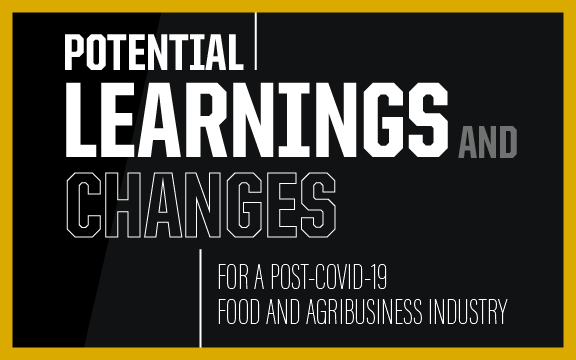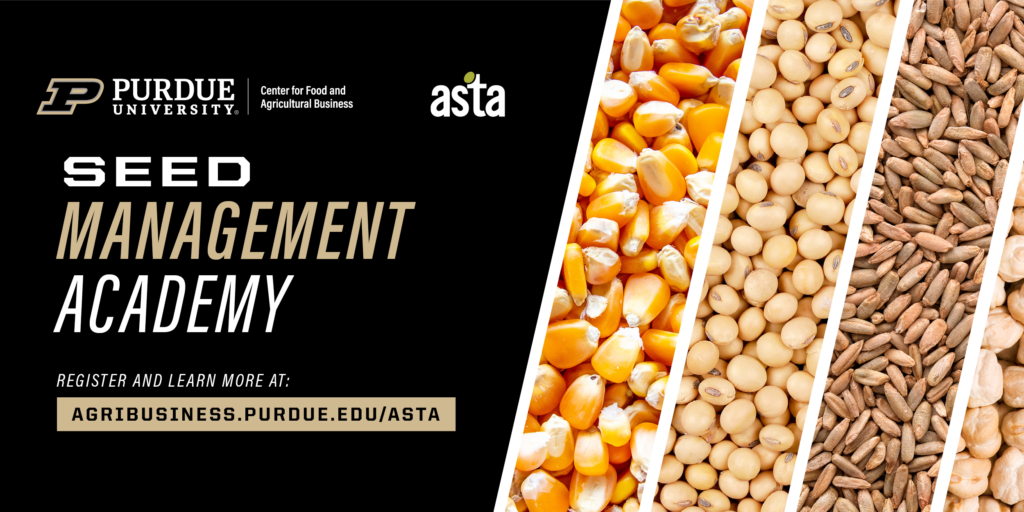Author: Dr. Allan W. Gray, Executive Director and Professor
Overview
COVID-19 has sent shock waves throughout the world, challenging every aspect of life. During this time of great tragedy and uncertainty, peoples’ daily lives have been disrupted in an abundance of ways. The concepts of communication, distance, work, food and even shopping are suddenly being redefined. In the food and agricultural business world, this tragedy has resulted in the examination of many aspects of business from the design of supply chains to impacts on consumer buying behaviors to the future of international trade. Has this massive disruption brought a new awareness to risk preparedness, co-dependencies in supply chains and the risks of the pursuit of efficiency at all costs? What are the ramifications of forced use of technology to communicate, buy and arrange for deliveries on the selling and buying functions of farms and agribusinesses? Have we shifted to a longer-term view where things like climate change and sustainability are embraced as part of the grand challenges of the industry, or have these issues been placed on a back burner as we focus on the here and now? Have we started to think about and implement new performance metrics that measure the industry and firm survivability, not just profitability? Ultimately, in the aftermath of this global tragedy, what can we learn about the future of the food and agribusiness industry that can help us create more resilient markets, supply chains, firms, leaders and employees?
Key Themes to Consider
Abrupt Demand Shocks – Markets such as fresh fruit and vegetables and milk faced sudden and dramatic downturns in demand as institutional buyers stopped purchasing in a matter of days. How did farms and companies survive this downturn? How has the industry been reshaped following the pandemic? Are there different actors in the market? Have relationships changed? Are supply chains being restructured? Are supply linkages being strengthened, or are arm’s length market exchanges the preferred risk mitigation strategy? What are the implications for farmers and companies supplying these markets in this new world? Have they changed their thinking about diversifying their markets? What were the supply challenges of meeting demand once it returned in these markets?
Redefined Food Consumers – Food away from home has declined drastically during this pandemic. Consumers are buying food for home in unprecedented amounts, and families have been reintroduced to shared meal times in the home. Food preparation techniques are being learned by a generation that had never been exposed before, and food as a necessity seems to be usurping food as fashion, at least temporarily. In short, the consumer’s relationship to food has suddenly been reshaped. What are the implications of this reshaping of the food relationship? How will the food chain adapt to this new world where perhaps food at home remains dominant to outside food for a period of time? How have demand surges created by tight supplies for meat proteins, bread and paper products (toilet paper) changed the way purchasers in grocery firms think about procuring supplies in the future? How has the experience of rationing changed the consumer mindset about purchasing frequency, purchasing quantity and the need for in-home storage?
Globalization or Localization – How have shocks in long-supply chains and reliance on foreign suppliers in critical industries changed the mindset of some industries, and, maybe more importantly, the mindset of policymakers about the need and/or desire for more local-based supplies and less reliance on international markets? Essentially, are we looking at more protectionism around the globe? What are the implications for food and agribusiness where so much of agriculture is highly dependent on export markets? Will focus shift even more toward the local food movement? How might this affect commodity markets? In an era where excess supply of commodities already seems to be at play, does this exacerbate the excess supply problem, further depressing commodity prices? What margin opportunities may exist for companies that can pivot to a more localized market?
Short-Term or Long-Term Optimization – The agricultural industry has historically been characterized by a low-margin business where firms with the lowest costs have the advantage. The singular focus on efficiency and driving down costs may have been at the expense of supply chains with more resilience to shocks. Will we see the focus in these markets shift toward practices that create more resilience such as less JIT inventory management, more working capital on hand, increased staffing to create a more flexible and adaptable workforce, etc.? Will a depressed commodity market dampen these strategies? Will these strategies favor larger or smaller firms? Will there be new metrics created to measure firms’ ability to survive black swan types of events that clearly balance the short-term measurement of profits and cost efficiency against the long-term survivability and resilience of the firm? Will the pandemic highlight the need for global approaches to common problems like climate change where the long-term benefits of current actions have to be weighed against short-term costs?
Digital Technology – The entire globe has been thrust into the digital world with the onset of COVID-19. Octogenarians are suddenly buying groceries online and having them delivered to their homes when they have never even purchased an item online before. Businesses are conducting meetings via platforms such as Zoom or Microsoft Teams that were previously believed could only happen face-to-face. The world is realizing the critical need for data to make effective decisions. Awareness for the need to share data, trust data sources, have timely data and the capabilities to analyze the data are all evermore clear. Will food and agribusinesses embrace the digital world more fervently in the post-pandemic world? Will we find ways to use digital and physical technologies to increase resilience to the black swan events while still driving efficiency? Will we redefine how we communicate and create relationships with our customers in this new world? Will e-commerce become more ubiquitous in agriculture? Will the nature of the sales call and the business-to-business consultation be redefined by less physical visits to the farm or business and more technology-driven interactions? Will we see a ramp up in the push for rural broadband as the current situation has highlighted the drastic gap in ability to communicate, educate and serve rural communities due to broadband limitations?
A special thank you goes to the Steering Committee of the Purdue Food and Agribusiness Executive Summit. This exceptional group of leaders in food and agribusiness recently dedicated two hours of their time to discuss these topics. It is their input that inspired much of the thinking in this writing.
:



